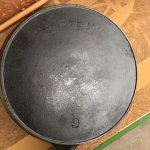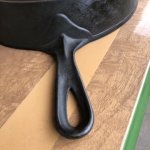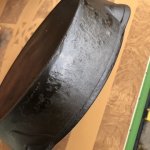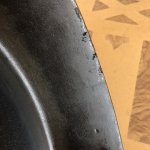Hi, I'm a new member, although I've been accumulating cast iron here and there for years now. I live in Canada, and recently found a couple of nice made in Canada Findlay and GSW skillets in a thrift store here, which have been sitting in the lye bath to clean. Those are great everyday users. The same day I also picked up a super crusty, gunked-up skillet that called out to me because the handle/pan joint was beautifully made, and I could faintly see what looked like a very old-fashioned number 9 and the edge of a heat ring. (It was so crusty that it was actually hard to tell). I figured it was worth $15 Canadian to see what it was.
After about a week in a chilly, slow lye bath (it's hovering around freezing here), I was able to make out a faint "Erie" logo, still under layers of seasoning, a nice outer heat ring, and no pattern number, so I figure it's a second series Erie #9 from the late 1880s. Score! However, I was also able to see some odd possible repairs that I haven't seen before. It almost looks like the outer wall was welded and then ground down, and there's a sidewall crack that looks to be about 1 1/2" long. The ground areas are a slightly different colour than the bare grey cast iron, more brassy, although it didn't really show up in the photos. Anyone have any thoughts or advice as to what the deal with this might be? Judging by the layers of grease that were hiding these (possible) repairs when I found it, it was used a lot after the fact.
I appreciate any input! Thanks!




After about a week in a chilly, slow lye bath (it's hovering around freezing here), I was able to make out a faint "Erie" logo, still under layers of seasoning, a nice outer heat ring, and no pattern number, so I figure it's a second series Erie #9 from the late 1880s. Score! However, I was also able to see some odd possible repairs that I haven't seen before. It almost looks like the outer wall was welded and then ground down, and there's a sidewall crack that looks to be about 1 1/2" long. The ground areas are a slightly different colour than the bare grey cast iron, more brassy, although it didn't really show up in the photos. Anyone have any thoughts or advice as to what the deal with this might be? Judging by the layers of grease that were hiding these (possible) repairs when I found it, it was used a lot after the fact.
I appreciate any input! Thanks!




